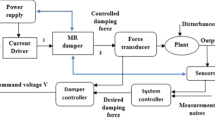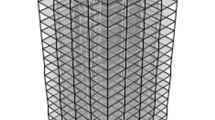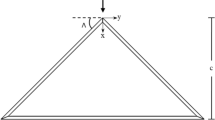Abstract
To improve the slow shaking, impact, and other issues of high-rise building targets caused by strong winds, a novel balancing unit of anti-shaking and anti-impact control moment gyroscopes (CMG) is proposed based on the gyroscopic effect, and its anti-impact performance is analyzed by simulation. First, the structural design of the balancing unit was provided, and a dynamic model of the balancing unit was established using Lagrange’s equations. Second, a simulation of the control algorithm is conducted using both PID control based on the transfer function and sliding mode control (SMC) based on the approach law. Finally, based on the three-dimensional model and control algorithm, an anti-impact integrated simulation of the balancing unit was performed. The effectiveness of the designed control law and anti-impact technique was verified through simulations. It was concluded that the proposed novel balancing unit has good impact resistance and can provide a new solution for anti-shaking and anti-impact applications in high-rise building targets.












Similar content being viewed by others
Availability of data and materials
No data were used for the research described in the article.
References
Etedali S, Tavakoli S (2017) PD/PID controller design for seismic control of high-rise buildings using multi-objective optimization: a comparative study with lqr controller. J Earthq Tsunami 11(3):1750009
Qiao H, Huang P, De D (2022) Structural control of high-rise buildings subjected to multi-hazard excitations using inerter-based vibration absorbers. Eng Struct 266(1):114666
Kavyashree BG, Patil S, Rao VS (2020) Review on vibration control in tall buildings: from the perspective of devices and applications. Int J Dyn Control 9:1316–1331
Choi SW, Seo JH, Lee HM et al (2015) Wind-induced response control model for high-rise buildings based on resizing method. J Civ Eng Manag 21(2):239–247
Zhou W, Bi KM, Hao H et al (2023) Development of locally resonant meta-basement for seismic induced vibration control of high-rise buildings. Eng Struct 275:115229
Sun HL, Zhang K, Zhang PQ, Chen HB (2010) Application of dynamic vibration absorbers in floating raft system. Appl Acoust 71(3):250–257
Naicker EN, Li K (2017) Experimental investigation on a passive auto-tuning mass damper for vibration control. Int J Dyn Control 6:1047–1062
Chang Y, Zhou J, Wang K (2022) Theoretical and experimental investigations on semi-active quasi-zero-stiffness dynamic vibration absorber. Int J Mech Sci 21(4):106892
Xu Z, Gong X, Liao G (2010) An active-damping-compensated magnetorheo logical elastomer adaptive tuned vibration absorber. J Intell Mater Syst Struct 21(10):1039–1047
Shen YJ, Wang L, Yang SP (2012) Nonlinear dynamical analysis and parameters optimization of four semi-active on-off dynamic vibration absorbers. J Vib Control 19(1):143–160
Kim H, Kang J (2021) Application of semi-active TMD to tilted high-rise building structure subjected to seismic loads. Int J Steel Struct 21(5):1671–1679
Zhang J, Xue Y (2024) Intelligent control method research for high rise building vibration by integrating genetic algorithm and LSTM. IEEE Access 12:9810–9821
Xiang Y, Tan P, Wu J et al (2024) Bi-directional wind-induced vibration control of high-rise buildings using bi-directional rail variable friction pendulum-tuned mass damper. Eng Struct 303:117557
Liu H, Tang Z, Chen Y et al (2023) Frequency domain transfer function based multimodal design method for seismic mitigation of building structures. Structures 51:1539–1552
Zhou K, Li Q (2022) Vibration mitigation performance of active tuned mass damper in a super high-rise building during multiple tropical storms. Eng Struct 269:114840
Fang Z, Zhang J, Yang F et al (2022) Fatigue damage mitigation for welded beam-to-column connections in steel high-rise buildings using passive vibration control. Buildings (Basel) 12(11):1898
Zimmer M, Moritz S, Altay O et al (2022) Hierarchical model predictive vibration control for high-rise structures using semi-active tuned liquid column damper. Struct Control Health Monitor 29(10):20. https://doi.org/10.1002/stc.3034
Li C, Zhang N, Fan XL et al (2019) Impact behaviors of cantilevered nano-beams based on the nonlocal theory. J Vib Eng Technol 7(5):533–542
Beake BD, Bergdoll L, Isern L et al (2021) Influence of probe geometry in micro-scale impact testing of nano-multilayered TiAlCrN/NbN coatings deposited on WC-Co. Int J Refract Met Hard Mater 95:105441
Shi X, Chen J, Beake BD et al (2021) Dynamic contact behavior of graphite-like carbon films on ductile substrate under nano/micro-scale impact. Surf Coat Technol 422:127515
Dong JL, Song X, Wang ZJ et al (2021) Impact resistance of single-layer metallic glass nanofilms to high-velocity micro-particle penetration. Extreme Mech Lett 44:101258
Li W, Chen H-Y (2023) Tuning the primary resonance of vibrating beam micro-gyroscopes based on piezoelectric actuation and nonlinearity in curvature and inertia. Microsyst Technol 29:387–403
Silva Trentin JF (2022) Dynamic modeling and control of a spherical pendulum with a vscmg. J Braz Soc Mech Sci Eng 44(8):335–349
Hartono R, Kim SB, Kalend PTA (2023) Design of self-balancing model-size electrical motorbike robot using control moment gyroscope. Sens Mater 35:347–363
Zhang X, Liu Q, Liu J (2021) Using gyro stabilizer for active anti-rollover control of articulated wheeled loader vehicles. Proc Inst Mech Eng Part I J Syst Control Eng 235(2):237–248
Park SH, Yi SYJIJoC (2020) Active balancing control for unmanned bicycle using scissored-pair control moment gyroscope. Int J Control Autom Syst 18(1):217–224
Romtrairat P, Virulsri C, Wattanasiri P (2020) A performance study of a wearable balance assistance device consisting of scissored-pair control moment gyroscopes and a two-axis inclination sensor. J Biomech 109(1):109957
Li W, Yang XD, Zhang W, Ren Y, Yang TZ (2019) Free vibrations and energy transfer analysis of the vibrating piezoelectric gyroscope based on the linear and nonlinear decoupling methods. J Vib Acoust 141(04):041015
Jones L, Peck M (2009) A generalized framework for linearly-constrained singularity-free control moment gyro steering laws. AIAA Guid Navig Control Conf 35(4):1094–1103
Zhao K, Cao D, Huang W (2018) Maneuver control of the hypersonic gliding vehicle with a scissored pair of control moment gyros. Sci China Technol Sci 61(8):1150–1160. https://doi.org/10.1007/s11431-017-9164-6
Saito R (2022) A gile rest-to-rest attitude maneuvering of spacecraft using pyramid-type SGCMG based on iteratively recalculated optimal trajectory. Adv Space Res 70(7):1988–2012
Acknowledgements
The authors gratefully acknowledge support from the National Natural Science Foundation of China (Grant Nos. 12332001, 12322202), and the National Key Laboratory of Helicopter Aeromechanics Fund (61422202206).
Funding
National Natural Science Foundation of China (Grant Nos. 12332001, 12322202), National Key Laboratory of Helicopter Aeromechanics Fund (61422202206).
Author information
Authors and Affiliations
Contributions
Zeng-De Shao involved in conceptualization, validation, resources, and investigation. Xiao-Fei Ding involved in validation, resources, and supervision. Ji-Hou Yang involved in conceptualization, methodology, investigation, writing—original draft, and writing—review and editing. Xiao-Dong Yang involved in resources, funding acquisition, and supervision.
Corresponding author
Ethics declarations
Conflict of interest
We declare that we have no financial and personal relationships with other people or organizations that can inappropriately influence our work, and there is no professional or other personal interest of any nature or kind in any product, service and/or company that could be construed as influencing the position presented in, or the review of, the manuscript entitled “Structure Design and Anti-impact Simulation Analysis of Unidirectional Balancing Unit Based on Control Moment Gyroscopes”.
Rights and permissions
Springer Nature or its licensor (e.g. a society or other partner) holds exclusive rights to this article under a publishing agreement with the author(s) or other rightsholder(s); author self-archiving of the accepted manuscript version of this article is solely governed by the terms of such publishing agreement and applicable law.
About this article
Cite this article
Shao, ZD., Ding, XF., Yang, JH. et al. Structure design and anti-impact simulation analysis of unidirectional balancing unit based on control moment gyroscopes. Int. J. Dynam. Control (2024). https://doi.org/10.1007/s40435-024-01432-5
Received:
Revised:
Accepted:
Published:
DOI: https://doi.org/10.1007/s40435-024-01432-5




